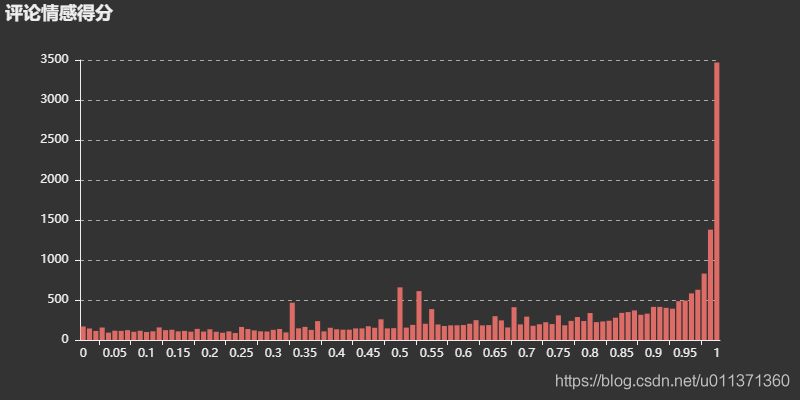目錄
- 前言
- 算法原理
- 目標函數
- 算法流程
- Python實現
- 總結
前言
K-Means 是一種非常簡單的聚類算法(聚類算法都屬于無監(jiān)督學習)�。給定固定數量的聚類和輸入數據集�����,該算法試圖將數據劃分為聚類���,使得聚類內部具有較高的相似性,聚類與聚類之間具有較低的相似性����。
算法原理
1. 初始化聚類中心���,或者在輸入數據范圍內隨機選擇��,或者使用一些現有的訓練樣本(推薦)
2. 直到收斂
- 將每個數據點分配到最近的聚類�。點與聚類中心之間的距離是通過歐幾里德距離測量得到的�。
- 通過將聚類中心的當前估計值設置為屬于該聚類的所有實例的平均值,來更新它們的當前估計值����。
目標函數
聚類算法的目標函數試圖找到聚類中心,以便數據將劃分到相應的聚類中����,并使得數據與其最接近的聚類中心之間的距離盡可能小��。
給定一組數據X1�����,...���,Xn和一個正數k,找到k個聚類中心C1�����,...�����,Ck并最小化目標函數:
 其中
其中 是質心�,計算表達式為
是質心�,計算表達式為

上圖a表達了初始的數據集,假設k=2�。在圖b中,我們隨機選擇了兩個k類所對應的類別質心��,即圖中的紅色質心和藍色質心�,然后分別求樣本中所有點到這兩個質心的距離,并標記每個樣本的類別為和該樣本距離最小的質心的類別,如圖c所示���,經過計算樣本和紅色質心和藍色質心的距離����,我們得到了所有樣本點的第一輪迭代后的類別�。此時我們對我們當前標記為紅色和藍色的點分別求其新的質心,如圖4所示����,新的紅色質心和藍色質心的位置已經發(fā)生了變動。圖e和圖f重復了我們在圖c和圖d的過程��,即將所有點的類別標記為距離最近的質心的類別并求新的質心�����。最終我們得到的兩個類別如圖f�����。當然在實際K-Mean算法中�����,我們一般會多次運行圖c和圖d���,才能達到最終的比較優(yōu)的類別���。
算法流程
注意點:
- 對于K-Means算法,首先要注意的是k值的選擇�,一般來說,我們會根據對數據的先驗經驗選擇一個合適的k值����,如果沒有什么先驗知識,則可以通過交叉驗證選擇一個合適的k值
- 在確定了k的個數后��,我們需要選擇k個初始化的質心����,就像上圖b中的隨機質心。由于我們是啟發(fā)式方法��,k個初始化的質心的位置選擇對最后的聚類結果和運行時間都有很大的影響�,因此需要選擇合適的k個質心,最好這些質心不能太近����。
流程:
輸入是樣本集D={x1,x2,...xm},聚類的簇樹k,最大迭代次數N
輸出是簇劃分C={C1,C2,...Ck}
1) 從數據集D中隨機選擇k個樣本作為初始的k個質心向量: {μ1,μ2,...,μk}
2)對于n=1,2,...,N
a) 將簇劃分C初始化為Ct=∅ t=1,2...k
b) 對于i=1,2...m,計算樣本xi和各個質心向量μj(j=1,2,...k)的距離: ,將xixi標記最小的為
,將xixi標記最小的為 所對應的類別
所對應的類別 。此時更新
。此時更新
c) 對于j=1,2,...,k,對Cj中所有的樣本點重新計算新的質心
e) 如果所有的k個質心向量都沒有發(fā)生變化����,則轉到步驟3)
3) 輸出簇劃分C={C1,C2,...Ck}
Python實現
import numpy as np
import matplotlib.pyplot as plt
import random
from sklearn.datasets import make_blobs
np.random.seed(123)
from sklearn.cluster import KMeans
class Kmeans:
def __init__(self,data,k):
self.data=data
self.k = k
def cluster_data_Bysklearn(self):
kmeans_model = KMeans(self.k,random_state=1)
labels = kmeans_model.fit(self.data).labels_
print(labels)
return labels
def kmeans(self):
# 獲取4個隨機數
rarray = np.random.random(size=self.k)
# 乘以數據集大小——>數據集中隨機的4個點
rarray = np.floor(rarray * len(self.data))
# 轉為int
rarray = rarray.astype(int)
print('數據集中隨機索引', rarray)
# 隨機取數據集中的4個點作為初始中心點
center = data[rarray]
# 測試比較偏、比較集中的點����,效果依然完美,測試需要刪除以上代碼
# center = np.array([[4.6,-2.5],[4.4,-1.7],[4.3,-0.7],[4.8,-1.1]])
# 1行80列的0數組�,標記每個樣本所屬的類(k[i])
cls = np.zeros([len(self.data)], np.int)
print('初始center=\n', center)
run = True
time = 0
n = len(self.data)
while run:
time = time + 1
for i in range(n):
# 求差
tmp = data[i] - center
# 求平方
tmp = np.square(tmp)
# axis=1表示按行求和
tmp = np.sum(tmp, axis=1)
# 取最小(最近)的給該點“染色”(標記每個樣本所屬的類(k[i]))
cls[i] = np.argmin(tmp)
# 如果沒有修改各分類中心點����,就結束循環(huán)
run = False
# 計算更新每個類的中心點
for i in range(self.k):
# 找到屬于該類的所有樣本
club = data[cls == i]
# axis=0表示按列求平均值,計算出新的中心點
newcenter = np.mean(club, axis=0)
# 如果新舊center的差距很小���,看做他們相等���,否則更新之����。run置true,再來一次循環(huán)
ss = np.abs(center[i] - newcenter)
if np.sum(ss, axis=0) > 1e-4:
center[i] = newcenter
run = True
print('new center=\n', center)
print('程序結束��,迭代次數:', time)
# 按類打印圖表,因為每打印一次���,顏色都不一樣�����,所以可區(qū)分出來
# for i in range(self.k):
# club = data[cls == i]
# self.showtable(club)
# 打印最后的中心點
self.showtable(center)
#打印聚類標簽
print(cls)
def showtable(self,data):
x = data.T[0]
y = data.T[1]
plt.scatter(x, y)
plt.show()
if __name__ == '__main__':
data = np.random.rand(10,2)
K = 4
model = Kmeans(data,K)
model.kmeans()
model.cluster_data_Bysklearn()
結果:
自寫得出的 [0 2 0 0 0 2 3 2 1 2]
調用模型的出的[0 2 0 1 0 2 3 2 3 0]
jupyter notebook實現
import numpy as np
import matplotlib.pyplot as plt
import random
from sklearn.datasets import make_blobs
%matplotlib inline
X, y = make_blobs(centers=6, n_samples=1000)
print(f'Shape of dataset: {X.shape}')
fig = plt.figure(figsize=(8,6))
plt.scatter(X[:,0], X[:,1], c=y)
plt.title("Dataset with 6 clusters")
plt.xlabel("First feature")
plt.ylabel("Second feature")
plt.show()

class KMeans():
def __init__(self, n_clusters=6):
self.k = n_clusters
def fit(self, data):
"""
Fits the k-means model to the given dataset
"""
n_samples, _ = data.shape
# initialize cluster centers
self.centers = np.array(random.sample(list(data), self.k))
self.initial_centers = np.copy(self.centers)
# We will keep track of whether the assignment of data points
# to the clusters has changed. If it stops changing, we are
# done fitting the model
old_assigns = None
n_iters = 0
while True:
new_assigns = [self.classify(datapoint) for datapoint in data]
if new_assigns == old_assigns:
print(f"Training finished after {n_iters} iterations!")
return
old_assigns = new_assigns
n_iters += 1
# recalculate centers
for id_ in range(self.k):
points_idx = np.where(np.array(new_assigns) == id_)
datapoints = data[points_idx]
self.centers[id_] = datapoints.mean(axis=0)
def l2_distance(self, datapoint):
dists = np.sqrt(np.sum((self.centers - datapoint)**2, axis=1))
return dists
def classify(self, datapoint):
"""
Given a datapoint, compute the cluster closest to the
datapoint. Return the cluster ID of that cluster.
"""
dists = self.l2_distance(datapoint)
return np.argmin(dists)
def plot_clusters(self, data):
plt.figure(figsize=(12,10))
plt.title("Initial centers in black, final centers in red")
plt.scatter(data[:, 0], data[:, 1], marker='.', c='y')
plt.scatter(self.centers[:, 0], self.centers[:,1], c='r')
plt.scatter(self.initial_centers[:, 0], self.initial_centers[:,1], c='k')
plt.show()
X = np.random.randn(10,100)
kmeans = KMeans(n_clusters=6)
kmeans.fit(X)
for data in X:
print(kmeans.classify(data))
總結
K-Means的主要優(yōu)點:
1)原理簡單�,容易實現
2)可解釋度較強
K-Means的主要缺點:
1)K值很難確定
2)局部最優(yōu)
3)對噪音和異常點敏感
4)需樣本存在均值(限定數據種類)
5)聚類效果依賴于聚類中心的初始化
6)對于非凸數據集或類別規(guī)模差異太大的數據效果不好
到此這篇關于利用Python如何實現K-means聚類算法的文章就介紹到這了,更多相關Python實現K-means聚類算法內容請搜索腳本之家以前的文章或繼續(xù)瀏覽下面的相關文章希望大家以后多多支持腳本之家��!
您可能感興趣的文章:- python中實現k-means聚類算法詳解
- python實現鳶尾花三種聚類算法(K-means,AGNES,DBScan)
- python基于K-means聚類算法的圖像分割
- K-means聚類算法介紹與利用python實現的代碼示例
- Python機器學習之K-Means聚類實現詳解
- 在Python中使用K-Means聚類和PCA主成分分析進行圖像壓縮
- Python機器學習算法之k均值聚類(k-means)
- python實現k-means聚類算法
- Python用K-means聚類算法進行客戶分群的實現
- k-means 聚類算法與Python實現代碼